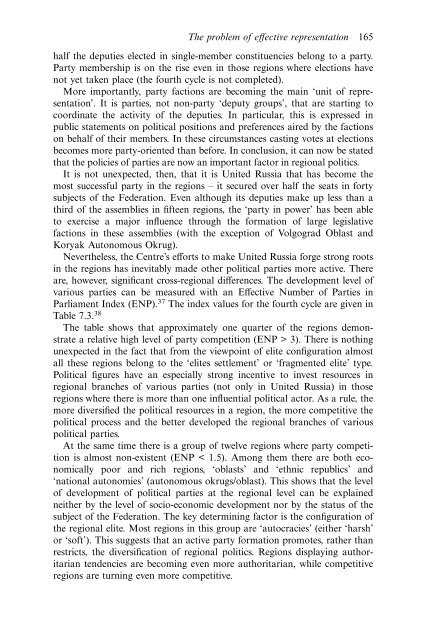Federalism and Local Politics in Russia
Federalism and Local Politics in Russia
Federalism and Local Politics in Russia
Create successful ePaper yourself
Turn your PDF publications into a flip-book with our unique Google optimized e-Paper software.
The problem of effective representation 165half the deputies elected <strong>in</strong> s<strong>in</strong>gle-member constituencies belong to a party.Party membership is on the rise even <strong>in</strong> those regions where elections havenot yet taken place (the fourth cycle is not completed).More importantly, party factions are becom<strong>in</strong>g the ma<strong>in</strong> ‘unit of representation’.It is parties, not non-party ‘deputy groups’, that are start<strong>in</strong>g tocoord<strong>in</strong>ate the activity of the deputies. In particular, this is expressed <strong>in</strong>public statements on political positions <strong>and</strong> preferences aired by the factionson behalf of their members. In these circumstances cast<strong>in</strong>g votes at electionsbecomes more party-oriented than before. In conclusion, it can now be statedthat the policies of parties are now an important factor <strong>in</strong> regional politics.It is not unexpected, then, that it is United <strong>Russia</strong> that has become themost successful party <strong>in</strong> the regions – it secured over half the seats <strong>in</strong> fortysubjects of the Federation. Even although its deputies make up less than athird of the assemblies <strong>in</strong> fifteen regions, the ‘party <strong>in</strong> power’ has been ableto exercise a major <strong>in</strong>fluence through the formation of large legislativefactions <strong>in</strong> these assemblies (with the exception of Volgograd Oblast <strong>and</strong>Koryak Autonomous Okrug).Nevertheless, the Centre’s efforts to make United <strong>Russia</strong> forge strong roots<strong>in</strong> the regions has <strong>in</strong>evitably made other political parties more active. Thereare, however, significant cross-regional differences. The development level ofvarious parties can be measured with an Effective Number of Parties <strong>in</strong>Parliament Index (ENP). 37 The <strong>in</strong>dex values for the fourth cycle are given <strong>in</strong>Table 7.3. 38The table shows that approximately one quarter of the regions demonstratea relative high level of party competition (ENP > 3). There is noth<strong>in</strong>gunexpected <strong>in</strong> the fact that from the viewpo<strong>in</strong>t of elite configuration almostall these regions belong to the ‘elites settlement’ or ‘fragmented elite’ type.Political figures have an especially strong <strong>in</strong>centive to <strong>in</strong>vest resources <strong>in</strong>regional branches of various parties (not only <strong>in</strong> United <strong>Russia</strong>) <strong>in</strong> thoseregions where there is more than one <strong>in</strong>fluential political actor. As a rule, themore diversified the political resources <strong>in</strong> a region, the more competitive thepolitical process <strong>and</strong> the better developed the regional branches of variouspolitical parties.At the same time there is a group of twelve regions where party competitionis almost non-existent (ENP < 1.5). Among them there are both economicallypoor <strong>and</strong> rich regions, ‘oblasts’ <strong>and</strong> ‘ethnic republics’ <strong>and</strong>‘national autonomies’ (autonomous okrugs/oblast). This shows that the levelof development of political parties at the regional level can be expla<strong>in</strong>edneither by the level of socio-economic development nor by the status of thesubject of the Federation. The key determ<strong>in</strong><strong>in</strong>g factor is the configuration ofthe regional elite. Most regions <strong>in</strong> this group are ‘autocracies’ (either ‘harsh’or ‘soft’). This suggests that an active party formation promotes, rather thanrestricts, the diversification of regional politics. Regions display<strong>in</strong>g authoritariantendencies are becom<strong>in</strong>g even more authoritarian, while competitiveregions are turn<strong>in</strong>g even more competitive.
















